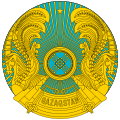Aralkum
History
While the level of the Aral Sea has fluctuated over its existence, the most recent level drop since the 1960s was caused by the Soviet Union building massive irrigation projects in the region. The severely reduced inflow caused the water level in the Aral Sea to drop. While the North Aral Sea rose due to the Dike Kokaral, the South Aral Sea kept dropping, thus expanding the size of the desert, until 2010, when the South Aral Sea was partly reflooded. The water level of the South Aral Sea then began to drop again, this time more severely.
In August 2021, British polar athlete Rosie Stancer led the first expedition on foot across the Aralkum desert.
Stranded boats
Before its desertification, the Aral Sea sustained a large fishing industry that provided up to one-sixth of the Soviet Union's fish. As the water receded, many fishing vessels and other boats were left behind in the desert. In the former port of the city of Moʻynoq, rusting vessels have become a tourist attraction and the site of the Stihia Festival, Central Asia's largest electronic music festival.
Airborne contaminants

The sands of the Aralkum and the dust that originates from it contain pollutants. The desert's location is on a powerful west–east airstream that carries its polluted dust around the globe. Aral dust has been found in the fields of Belarus, the forests of Norway, and in the glaciers of Greenland. Pesticides in the dust have been found in the blood of penguins in Antarctica.
See also
References
- ^ Aral Sea State of Environment of the Aral Sea Basin. Regional report of the Central Asian States. (2000) Archived 24 April 2008 at the Wayback Machine
- ^ geographyrealm (28 May 2014). "Aralkum Desert: The World's Newest Desert". Geography Realm. Archived from the original on 28 January 2022. Retrieved 28 January 2022.
- ^ "Aral Sea Tours from 450 USD: your Travel to the Aral Sea will be unforgettable with Peopletravel!". Archived from the original on 20 January 2016. Retrieved 15 January 2016.
- ^ Khissimova, Dana (30 August 2021). "British Polar Athletes Explore Aralkum desert in Kazakhstan". The Astana Times. Archived from the original on 14 December 2021. Retrieved 3 November 2022.
- ^ Dowling, Stephen. "The ghostly fishing fleet stranded in a desert". www.bbc.com. Archived from the original on 28 January 2022. Retrieved 28 January 2022.
- ^ Pandey, Anish Chandra; Jha, Niraj K (2007). "Central Asia: Democratic deficit and challenges of sustainable development". Journal of Environmental Research and Development. 1 (4): 403–411. Archived from the original on 17 December 2017. Retrieved 11 February 2016.
Salt, sand, and dust from exposed Aral Sea mud beds blow across the region, harming people and crops. The excessive use of pesticides and fertilizers from farms has poisoned food and drinking water. The human cost of the crisis has been high in the Aral Sea area. For instance, infant mortality rates have consistently been the highest in the former Soviet Union
- ^ "Archived copy". Archived from the original on 1 February 2016. Retrieved 24 May 2016.
{{cite web}}: CS1 maint: archived copy as title (link) "...typical Aral dust has been found on Greenland's glaciers, in Norway's forests, and Byelorussia's fields, all situated thousands of kilometers away from Central Asia." - ^ Nurushev, A (April 1999). "Crisis of the Aral Sea". Himalayan and Central Asian Studies. 3 (2): 50–58. Archived from the original on 21 October 2021. Retrieved 11 February 2016.
... The effect of pollution is aggravated by the fact that the Aral Sea is situated on the "highway" where strong currents of air are blowing from the west to the east. ... That is why pesticides from the Aral region are found in the blood of penguins living in the Antarctic continent.

